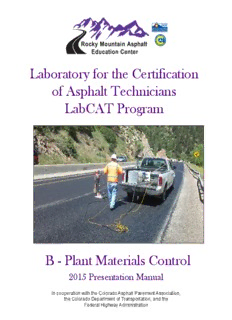
Plant Materials Control PDF
Preview Plant Materials Control
Laboratory for the Certification of Asphalt Technicians LabCAT Program B - Plant Materials Control 2015 Presentation Manual In cooperation with the Colorado Asphalt Pavement Association, the Colorado Department of Transportation, and the Federal Highway Administration 7/30/2014 SSttaannddaarrdd MMeetthhoodd ooff TTeesstt for Reducing Field Samples of Aggregate to Testing Size CDOT CP - 32 AASHTO T –248 Purpose of Splitting (cid:121) These methods provide for reducing large samples of aggregate to measure characteristics in a manner that the smaller test portion is most likely to be a reppresentation of the largger sampple,, and thus of the total supply 1 7/30/2014 (cid:121)(cid:121) AAggggrreeggaatteess mmuusstt bbee ssaammpplleedd iinn aaccccoorrddaannccee with CP-30. (cid:121) Samples must be split properly to obtain representative test specimens Methods (cid:121) Method A - riffle type splitter (cid:121) Method B - quartering (cid:121) Method C – ◦ selection by scoop (CDOT) ◦ miniature stockpile method (AASHTO) 2 7/30/2014 Riffle Apparatus (cid:121) Riffle type splitter with variable size openings (cid:121) Hopper to retain sample or Flat scoop (feeder pan) equal in length to the overall assembly of chutes (cid:121) Collection pans, minimum of two (2), equal in length to the overallll assembblly off chutes (cid:121) Splitter brush to clean chutes of adhering fines Quartering Apparatus (cid:121)(cid:121) 66’ xx 88’ quartering canvas or (cid:121) Clean, hard, level surface ((AASHTO)) (cid:121) Flat, square end shovel 3 7/30/2014 Scoop & Miniature Stockpile Apparatus (Fine Aggregate Only) (cid:121) Large flat bottomed mixing pan (CDOT) or a clean, hard, level surface (cid:121) SSmmaallll, ffllaatt, ssqquuaarree end scoop By Riffle Splitter (cid:121) Riffle splitting is always preferable to hand qquuaarrtteerriinngg. (cid:121) Proper size openings required. (cid:121) Opening shall permit easy passage of the largest pparticles in the sampple. (cid:121) For variable splitters the openings should be 1.5 times the size of the largest particles 4 7/30/2014 Method A - Riffle Splitter (cid:121) An even number of equal width chutes, but not less tthhan 88 ffor coarse, or 1122 ffor ffiine aggregattes (cid:121) The splitter shall be equipped with a hopper or straight-edged pan which has a width equal or slightly less the overall width of the assembly of chutes (cid:121) Sample at SSD or drier (cid:121) Two pprocedures to spplit sampple (cid:123)Hopper (cid:123)Scoop (feeder pan) Riffle Splitter-Control Flow Hopper (CDOT) (cid:121) Sample poured into the closed hopper from the sample container (cid:121) Use all material (cid:121) Uniformly distribute from edge to edge (cid:121) Open release handle and allow the sample to flow freely tthhrroouugghh tthhee cchhuutteess (cid:121) The first split that is then reintroduced to the splitter assists in mixing the sample 5 7/30/2014 Riffle Splitter-Control Flow Hopper (CDOT) (cid:124) Then remove both pans from the splitter (cid:124) Save material in one ppan for other tests (cid:124) Pour half of the remaining pan into the hopper (cid:124) Reverse endsof pan (cid:124) Pour the remaining sample into the hopper (cid:124) Uniformly distribute material in hopper (cid:124) Open release handle and allow the sample to flow freely through the chutes (cid:124)(cid:124) uussee aalltteerrnnaattee ppaannss ffoorr ffuurrtthheerr rreedduuccttiioonn (cid:124) Splitting is continued until the sample is reduced to the required specimen size Riffle Splitter (AASHTO) (cid:121) Splitting continued from one side until sample reduced to required specimen size 6 7/30/2014 Riffle Splitter without control hopper (CDOT) (cid:121) Place entire sampple in a large mixing pan and mix thoroughly (cid:121) Scoop the material from the pan with the feeder pan (cid:121) Uniformly distribute in ffeeeeddeerr ppaann (cid:121) First, slowly pour half the sample from one side Riffle Splitter without control flow hopper (CDOT) (cid:121) Pour the other half from the other side (cid:121) Continue until entire sample has been passed through the chutes (cid:121) Use alternate ppans for further reduction to desired specimen size 7 7/30/2014 Method B -Quartering (cid:121) Sample ddeeppoossiitteedd oonn clean, hard, level surface or canvas (6’ X 8’ canvas) (cid:121) Mix material thoroughly by ttuurrnniinngg tthhee eennttiirree sample over onto itself 3 times Method B -Quartering (cid:121) Material shoveled into cone (cid:121) Cone flattened at appex into in circular layyer (cid:121) Diameter equals approx. 4-8 times the thickness 8
Description: